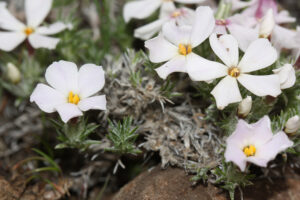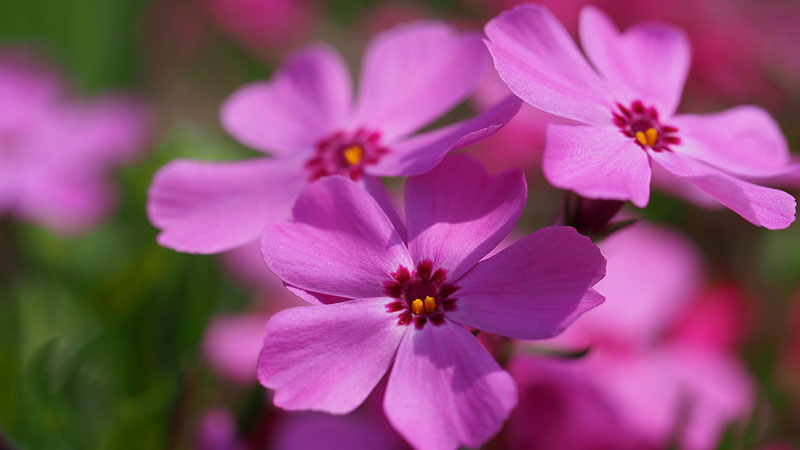Creeping Phlox
In springtime when the ground is bare, creeping phlox relieves the dullness with a flush of glorious pink, pristine white or pale mauve. In some varieties, this can deepen to almost-purple and then to magenta. There is also a picotee variety with white margins along the one-inch flowers.

Creeping phlox hugs the earth, sprawling as its name indicates, painting the ground with a thick blanket of bloom where the sun shines longest. It’s five-petalled, starry flowers, nestled in a bed of dark green, ferny foliage, can reach four to six inches toward the sun with each individual plant spreading as much as two feet. Even so, it is not invasive. It is native to North America but gardeners have taken it much further.
P. hoodii, also known as moss phlox, and P. diffusa or spreading phlox are likely to be found in prairies and westward to the Foothills from April to June. P. subulata smells a bit like marijuana and prefers sandy soil. There are as many as 50 species, both perennial and annual. (Annual phlox is taller, growing 8 to 20 inches tall).
While it blooms April through June, depending on the variety, pruning creeping phlox after blooming will prolong the flowering and promote mounding. The attractive foliage will continue to serve the border well after the flowers have died back.

Creeping phlox is easy to propagate through division or stem cuttings. In ideal conditions, you can simply poke a few pieces of stem lightly into moist soil, but you can also take careful cuttings and use growth hormone to ensure a solid start. For the thickest and most luxurious carpet, plant from seed directly in the ground (or start indoors eight weeks before the last frost). Seedlings emerge 11 to 21 days at temperatures above 18 degrees Celsius. Creeping phlox takes about two years to reach its full glory.
In the garden, it shows best in a rockery, but creeping phlox can also be a spectacular border planted in thick, luxurious swathes of colour. For the best bloom, fertilize in early spring with a slow release, balanced fertilizer.
Phlox is the Latin word for fire or flame. Imported to England in 1835, it became the Victorian flower symbol for sweet dreams. First nations people used various parts of phlox to treat colds, body aches, irritated eyes and stomach ailments including aches and diarrhea. It was also used to treat eczema.
The creative landscape gardener will find creeping phlox a welcome ally in developing an eye stopping panorama.
To get access to all our local content, subscribe now!




